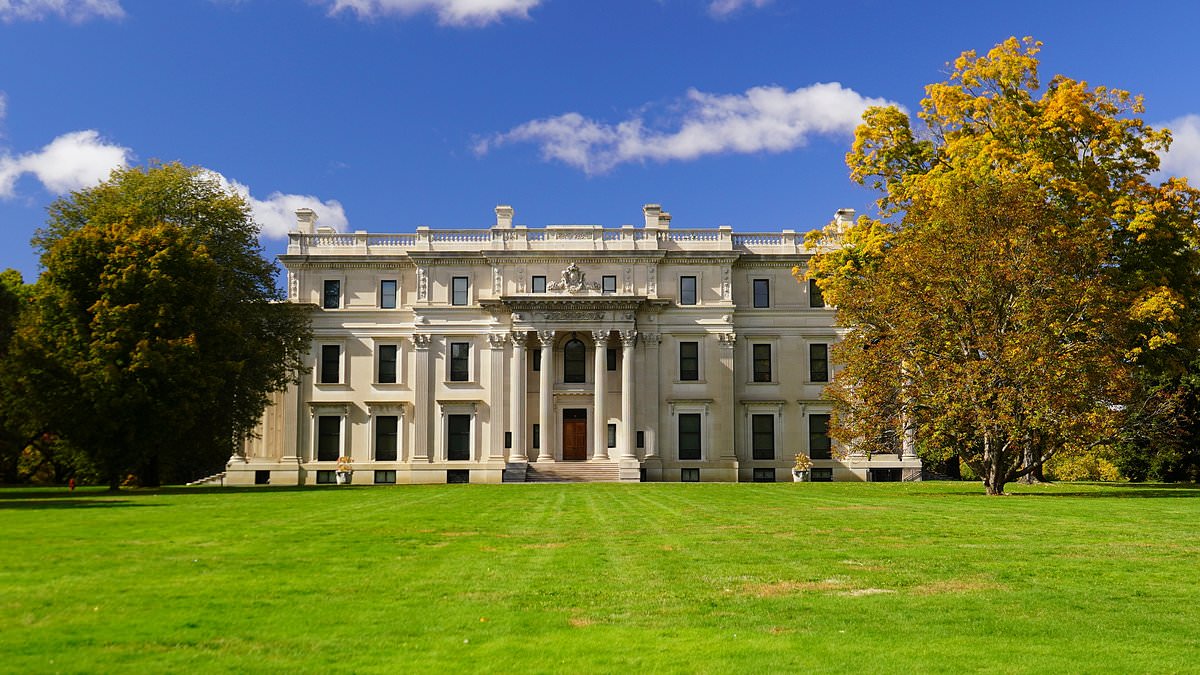Police have asked for help solving a mysterious suspicious death after a woman’s body was discovered in the grounds of the iconic Vanderbilt Mansion in New York.
The victim, believed to be in her 50s or 60s, was found on Vanderbilt Park Road in Hyde Park, roughly 100 miles north of New York City, on December 6.
A hiker spotted her ‘lying face down near the east shore of the Hudson River south of Bard Rock,’ according to the New York State Police.
She was described by the The Dutchess County Medical Examiner as a white 5-foot-5 woman with brown eyes, gray hair and no scars, marks, or tattoos. She was estimated to weigh 112 pounds.
Police have said her death is suspicious and have gone as far as to release a photograph of the decades so the public can help identify her.
DailyMail.com has reached out to the NYS Police for comment.
The mansion was owned by Frederick and Louise Vanderbilt and sits on a 211-acre historic site run by the National Park Service (NPS).
Frederick purchased the Langdon House in Hyde Park in 1895, compromising of 153 acres, a farm, and 459 acres on the east side of Post Road, according to NPS.

She was discovered after a hiker found her ‘lying face down near the east shore of the Hudson River south of Bard Rock’ on the estate’s grounds (pictured: Vanderbilt Mansion)

The woman, believed to be in her 50s or 60s, was found on Vanderbilt Park Road on the mansion’s historical grounds in Hyde Park , roughly 100 miles north of New York City , on December 6, sparking confusion and mystery among officers
He went on to build a new house that emulated the palaces of European nobility and the home became the model of other country homes by the extremely wealthy.
The Vanderbilts established their mass fortune prior to the Civil War, starting with Frederick’s grandfather Cornelius.
The patriarch built their family fortune on steamboating and investing in the railroad, which eventually became the New York Central and Hudson River Railroad.
When he died in 1877, he left behind a fortune of $100 million, or equivalent to roughly $3 billion today, which was more than entire US Treasury at the time.
The Vanderbilts were among some of New York’s wealthiest, including the Astors and Rockefellers.
Another Vanderbilt legacy is Vanderbilt University in Tennessee which was founded thanks to his $1million endowment in 1873.
The donation was made under the persuasion of his much younger second wife, Frank Crawford, who was an avowed Confederate sympathizer and distant cousin of her husband.
Cornelius left the bulk of his fortune to his son William Henry Vanderbilt. He was the only Vanderbilt who was able to double the family fortune.

The home was owned by Frederick and Louise Vanderbilt. Frederick purchased the Langdon House in Hyde Park in 1895. He went on to build a new house that emulated the palaces of European nobility and the home became the model of other country homes by the extremely wealthy

The Vanderbilts established their mass fortune prior to the Civil War, starting with Frederick’s grandfather Cornelius. The patriarch built their family fortune on steamboating and investing in the railroad

When he died in 1877, he left behind a fortune of $100million, or equivalent to roughly $3billion today, which was more than entire US Treasury at the time

The mansion sits on a 211-acre historic site that is owned by the National Park Service

Cornelius ‘Commodore’ Vanderbilt (pictured) was an upstart from Staten Island who quit school at the age of 11 and began working in his father’s ferry business
By the time William died in 1885, he amassed a staggering $200 million, or roughly $6.5 billion today, but all of it would be squandered within a few generations by heirs who only knew how to ‘live well, marry well’ and ‘spend lavishly.’
Third-generation Vanderbilts were keen to use their inheritance to infiltrate the gilded gates of New York Society.
Until that point, they were considered nouveau riche vulgarians by the old guard.
It would be their astonishing life of excess for which the family would become famous.
Cornelius II, wasted no time throwing his inheritance into building an enormous palace on Fifth Avenue which featured 100 rooms and filled an entire city block.
It was demolished in 1926, but it still holds the record for the largest private residence ever built in New York City to this day.
Today the most notable Vanderbilt descendent is Gloria’s son, Anderson Cooper, a journalist and political commentator for CNN.
‘The dynasty ended with Gloria,’ he said, in his 2021 book, which explored his family’s legacy.
‘She was the last to be born before the Depression, when the Vanderbilt riches seemed as limitless and eternal as the stars in the sky,’ he says in the book.
